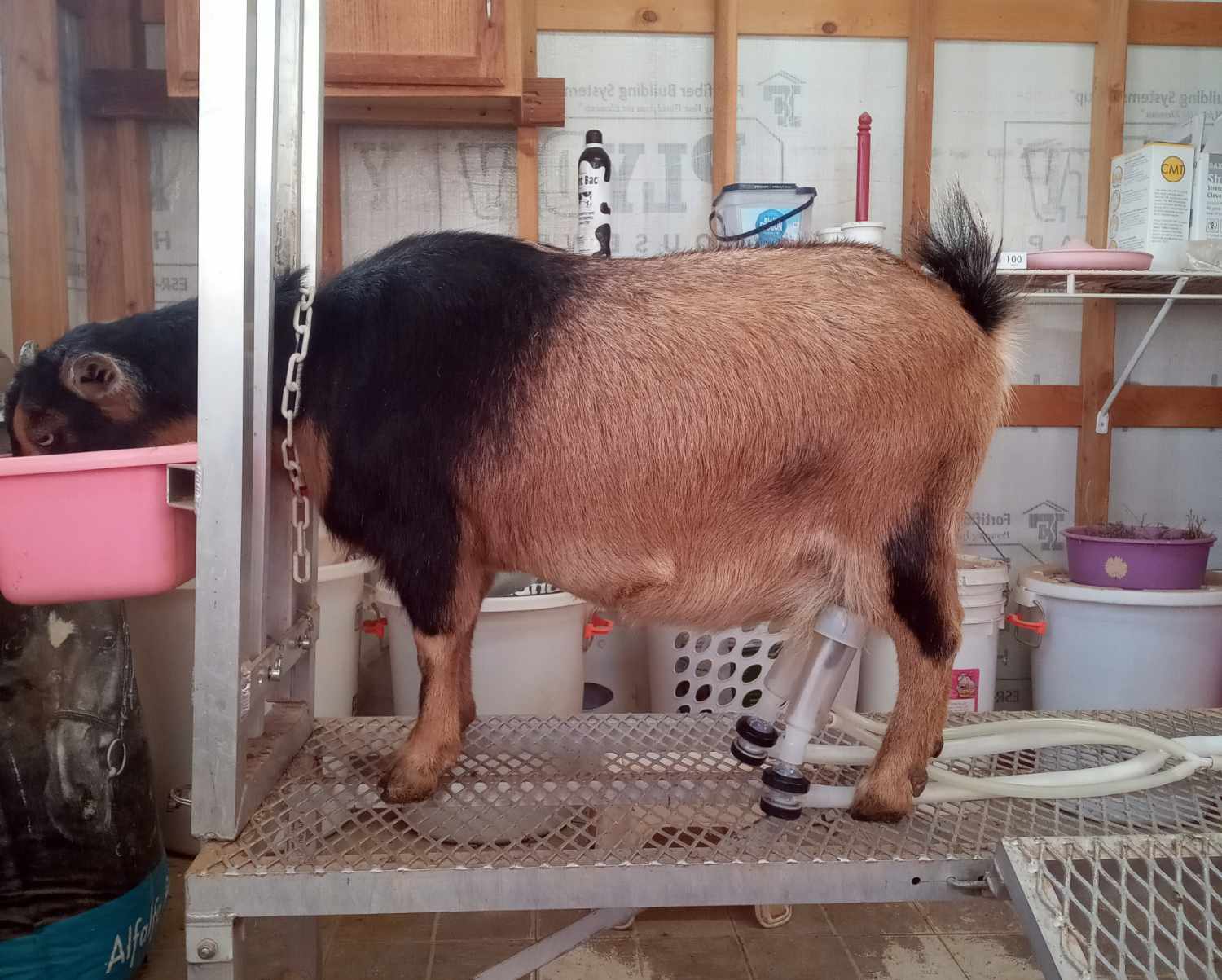
Maintaining udder health during your doe’s lactation is easy, but there is a proper protocol to keep mastitis away. If you have or plan to have goats in milk, there are a few things you need to keep the udder healthy. Proper cleaning of a dairy goat’s udder before and after milking will help with two important issues on your homestead. First, it will help keep your milk cleaner, which will allow it to stay clean and fresh longer once you get it in the house, and second, it will help the animal avoid mastitis, which is an udder infection that can get very serious without veterinary treatment.
Before I begin with the routine, the first thing I highly recommend you have on hand is a California Mastitis Test Kit (link below). If you ever suspect mastitis, you want that test kit on hand so you can diagnose a potential mastitis event and react to it quickly. With mastitis, the earlier treatment begins, the better off you and your goat will be. With the new antibiotic laws in effect, mastitis treatments that once were over-the-counter can now only be obtained by veterinary prescription.
The protocols we’ve adopted have evolved, and much of the fine-tuning was handed down to us by Dr. Michelle Schack, a veterinarian in Maricopa County, AZ, who specializes in dairy. Below, I will outline our simple but detailed procedures and why we do what we do.
Milking Protocol
- Clean loose dirt and debris from the udder and surrounding area. Things like mud and hay are easily brushed away with your hand, which will keep them from falling into your milk. Then, wipe down with a wet rag. We just use plain water and some soft reusable cloths (see link below). Use a fresh rag for each doe.
Best practice is to don gloves and then dip teats in an iodine teat dip. When dipping, be sure to cover the full teat up to the base of the udder and let sit on the udder for 60 seconds. Not only does the 60-second delay allow the iodine to work, but it also causes your doe to let down her milk. This was a tip passed to us by Dr. Schack. - After 60 seconds, strip each teat, then dry off excess iodine dip with the clean side of your rag. If you’re not using gloves, wipe, then strip. We strip onto the rag and check the consistency each time. Best practice is to strip into a stripping cup and analyze the milk that way. Stripping is done to detect mastitis and clear fore milk from the udder. If you see any mastitis indications, you need to grab your mastitis test kit and test before you milk out the doe. The last thing you want to do is to milk a doe with mastitis into your community milk pail and contaminate your milk with infection. Be sure to follow the kit’s instructions to avoid false positives. A test kit should always be on hand at every dairy homestead. The faster you act on the first signs of mastitis, the better.
- If milk strips out okay, begin milking.
- After milking, spray the teat orifice directly with two blasts of Fight Bac. You want to be 1/2″ below the teat when you spray toward the orifice. This is a chlorhexidine spray that helps to close down the orifice and kills certain bacteria that iodine does not, such as gangrene mastitis. Using both iodine and chlorhexidine gives you the best coverage for killing bacteria, as iodine will kill certain bacteria that chlorhexidine won’t and vice versa.
- You’re done. We have never needed to apply udder creams, but if this is something you need to do, apply 30 minutes after milking.
- Lastly, mastitis is primarily picked up from the soil. It is recommended that you have fresh hay and water available to the doe directly after milking to encourage the doe to stand for at least 30 minutes after milking. This time allows the doe’s teat orifice to close before the udder contacts the soil.
Signs of mastitis and what to do if you have it
Signs of mastitis will often present itself when you’re stripping milk from the teat. Stringy or clumping milk is a dead giveaway. The teat can also feel warmer than normal, be enlarged, or your doe may be sensitive when you’re trying to milk her out. It’s not uncommon to see it in one teat and not the other. As stated earlier, always have a mastitis test kit on hand so you can act quickly. If the Mastitis test comes back positive for mastitis, contact your veterinarian as soon as possible.
If a doe has mastitis, do not use a shared dip cup. Use a new Dixie cup each time that doe is milked, and throw out the iodine after each use. If only one teat has the infection and the other doesn’t, dip the uninfected teat first to keep from infecting an uninfected teat. Mastitis is highly contagious and can spread from animal to animal or teat to teat, so isolating the infection is critical. It’s best to milk mastitis animals last, and the best practice is to use gloves so infection isn’t transferred to other surfaces or animals. As you can see, mastitis isn’t fun, it isn’t cheap, and it can potentially ruin your dairy animal for life, so taking precautions to avoid it altogether can save you a lot of time, money, and hassle in the long run.
Note about gloves:
We realize many homesteads don’t wear gloves when milking, especially if you’re hand-milking. If this is something you’re not going to do, keep your hands clean and keep gloves on hand in the event you ever need to treat mastitis or any other infectious illness. Below is a link to a cheaper food-service glove that has worked well for us without breaking the bank.
Note about dip cups:
We’ve tried different dip cups, and our favorite cups are the foamer cups (see link below) because of their superior ability to get the iodine where you need it without making a huge mess. There is a potential for contamination using dip cups, but if you keep them clean and watch for early signs of mastitis, you minimize your risk, and iodine usage far outweighs the potential contamination risk. Keep your dip cups clean to reduce the risk of introducing unwanted bacteria. I buy two and switch out the tops so cleaning is easier.
Note about the usage of essential oils:
Some naturalists feel that essential oils are a good substitute for Iodine dips. They are not. They are not effective at killing bacteria that cause mastitis and I know of one farm that was using an essential oil protocol that contracted gangrene mastitis. Iodine is an essential trace mineral for all living things. Iodine is also highly effective at killing bacteria and is a good way for animals to get some of their iodine needs through absorption. Chlorhexidine is an antiseptic used in first aid and by hospitals for cleaning wounds. Fight Bac can be used as such for cleaning wounds on the farm, as well. We’ve had kids bite teats and Fight Bac is how we treat teat wounds such as this. Iodine and chlorhexidine are not harmful to animals or humans if used as directed.
Here is a list of products we use and recommend. Some links are affiliate links. We appreciate your support.
Soft udder rags
Iodine teat dip
Iodine foamer cups
Fight Bac
California Mastitis Test Kit
Gloves we use
